
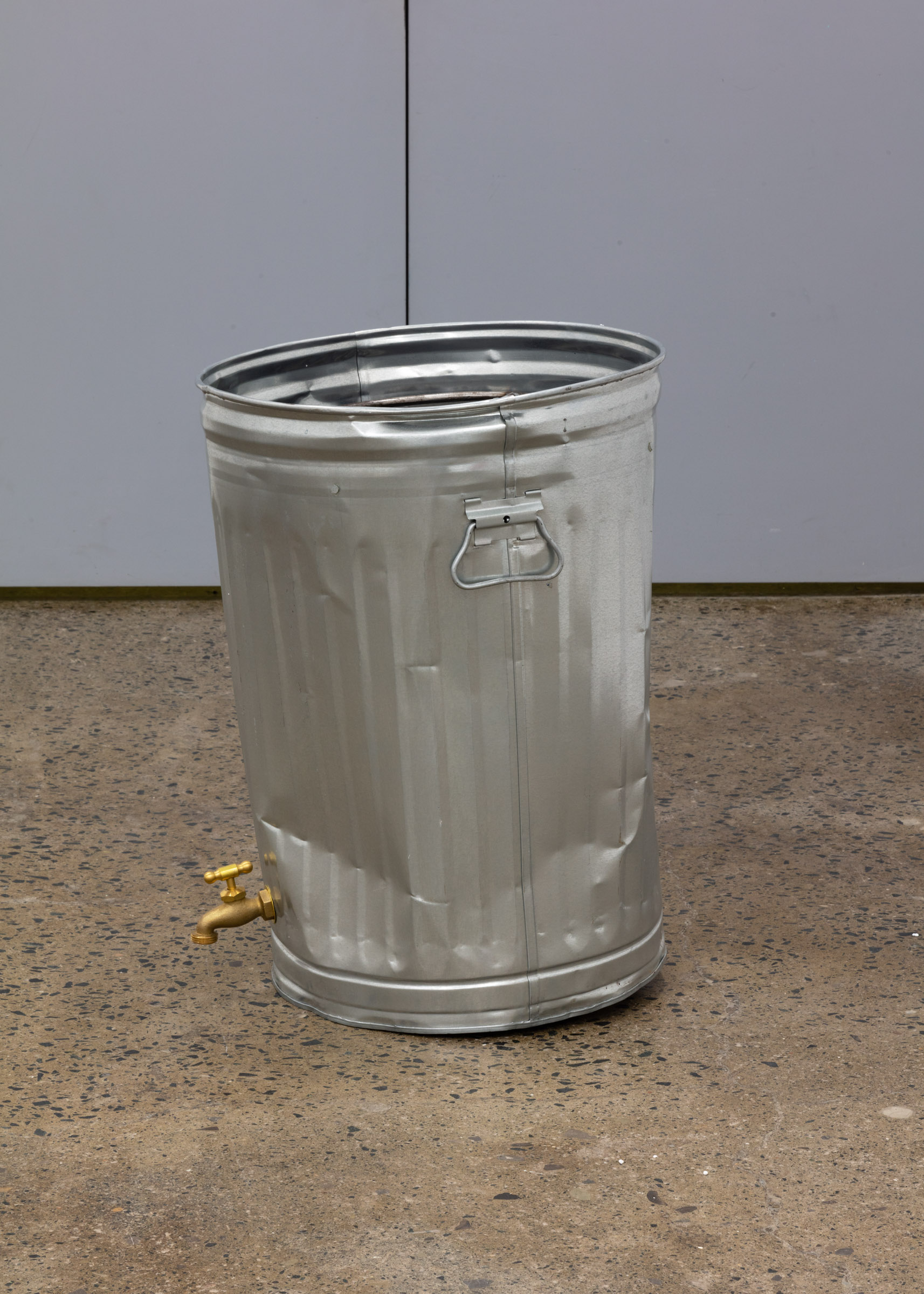

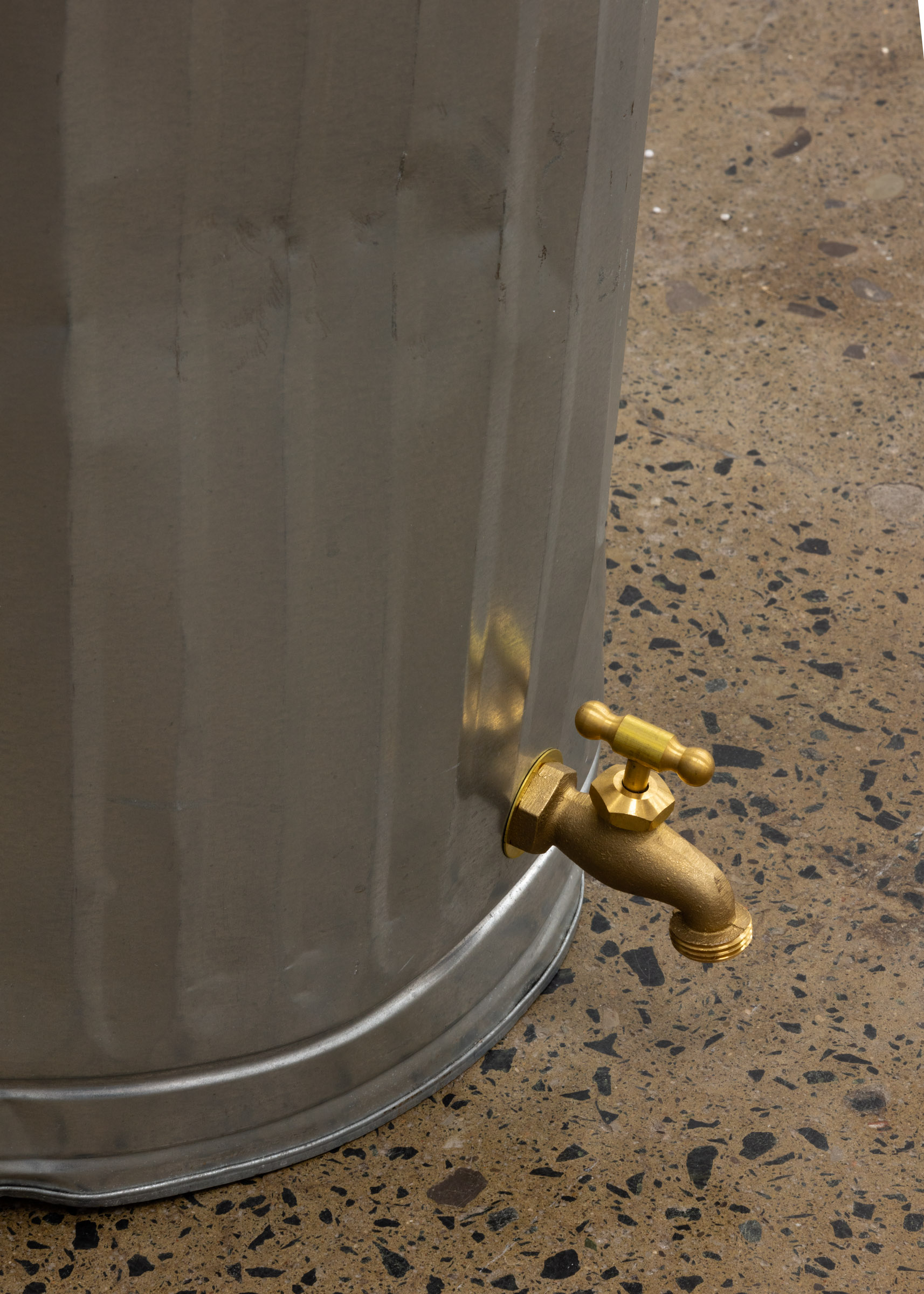
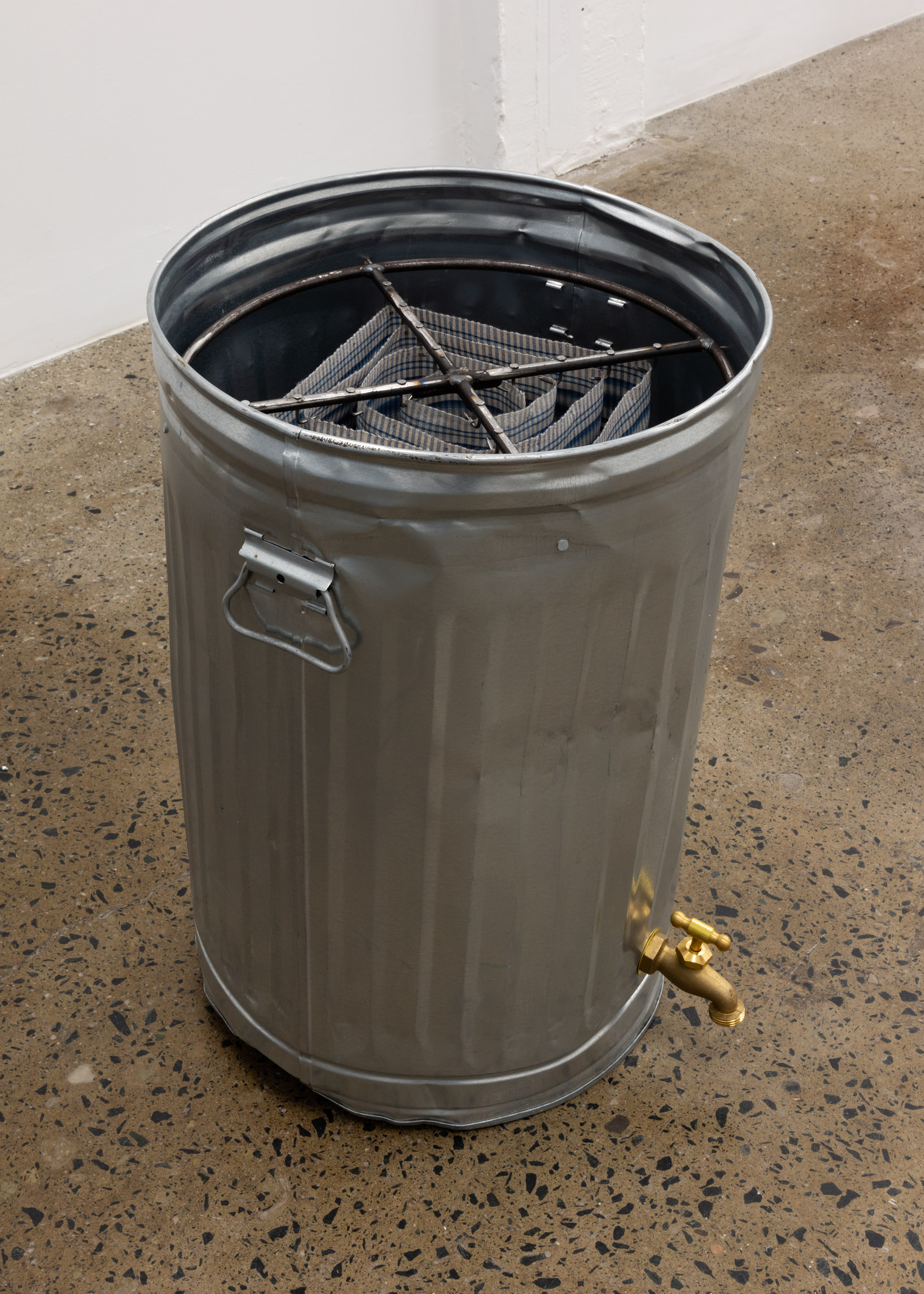

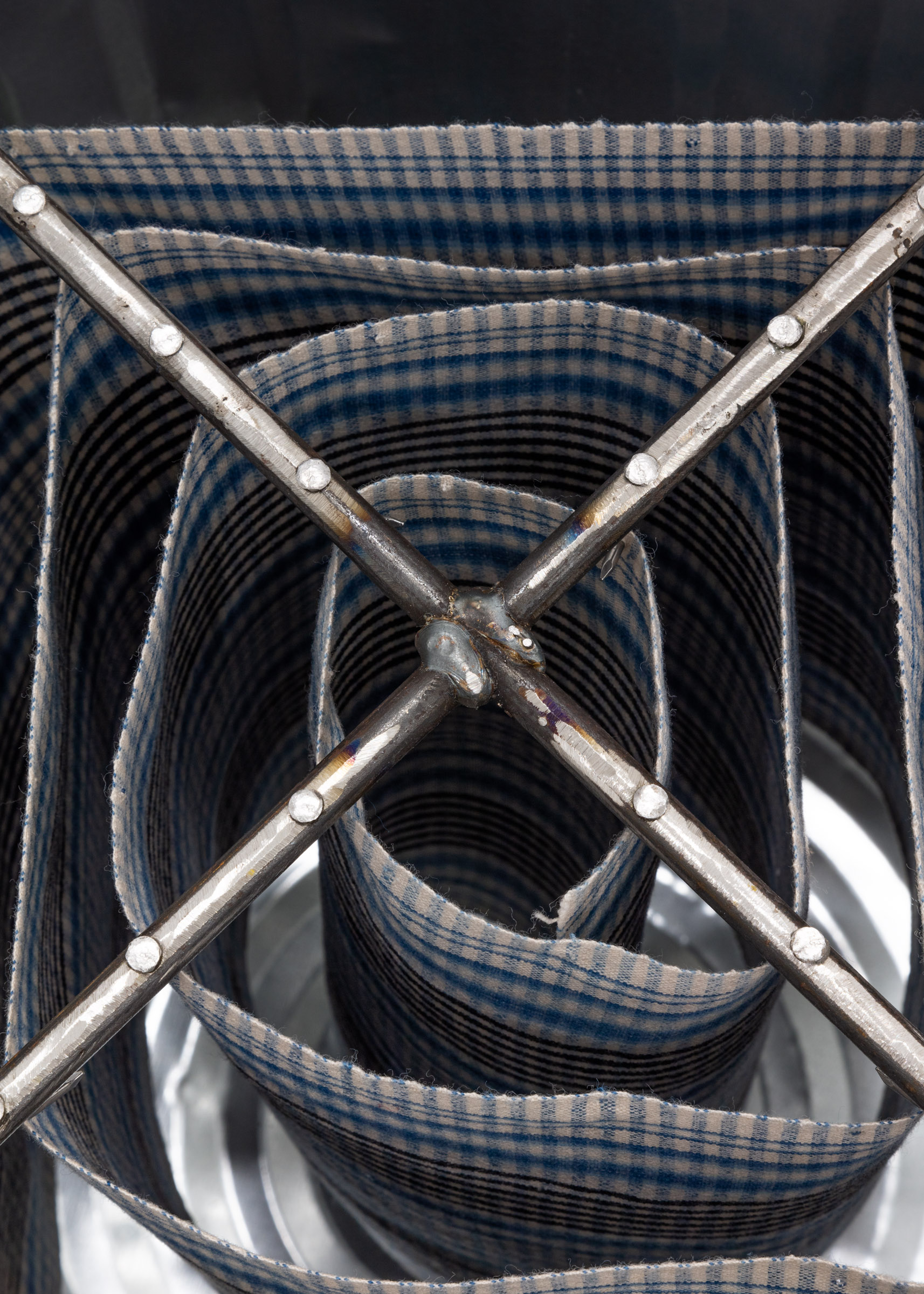
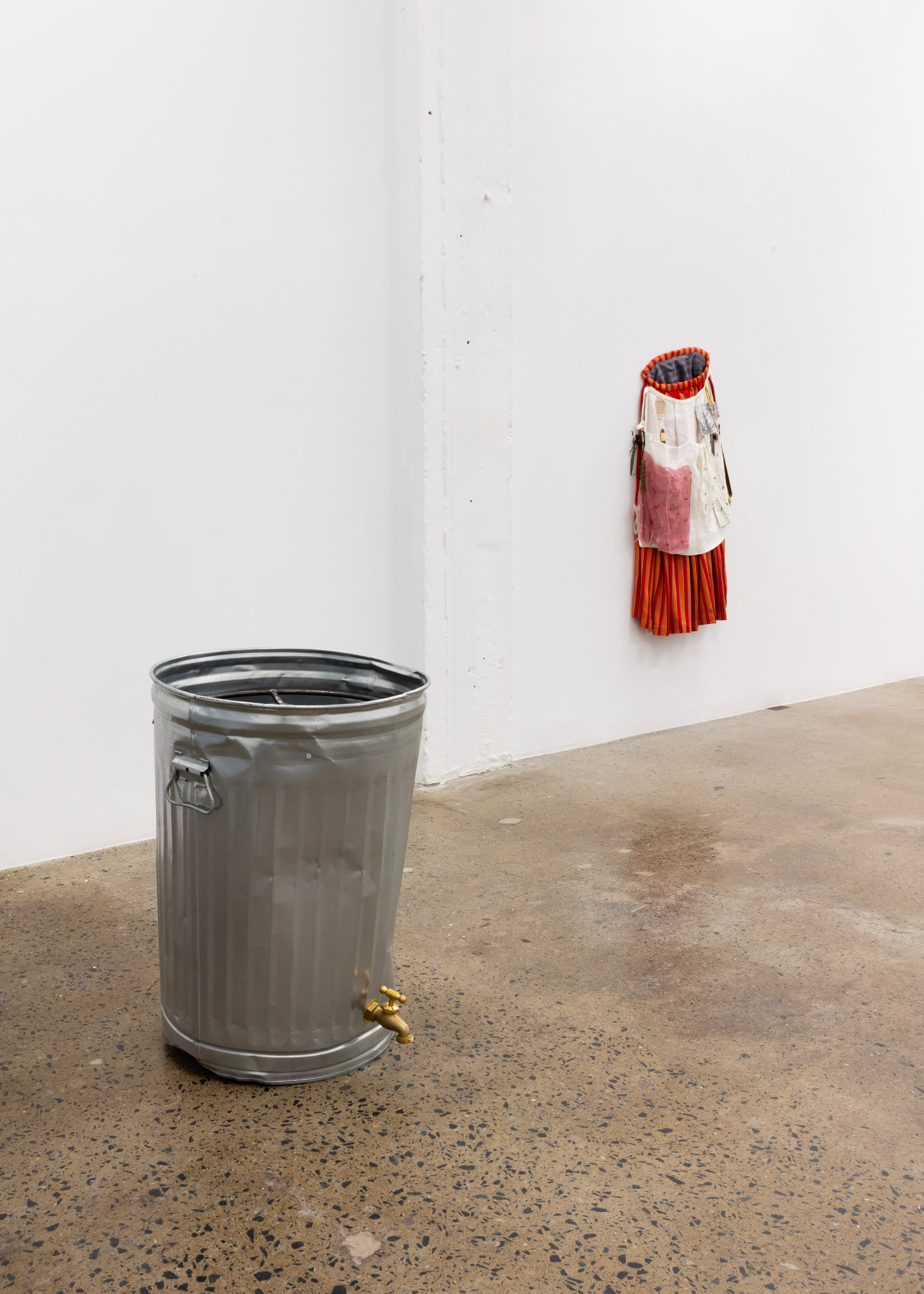
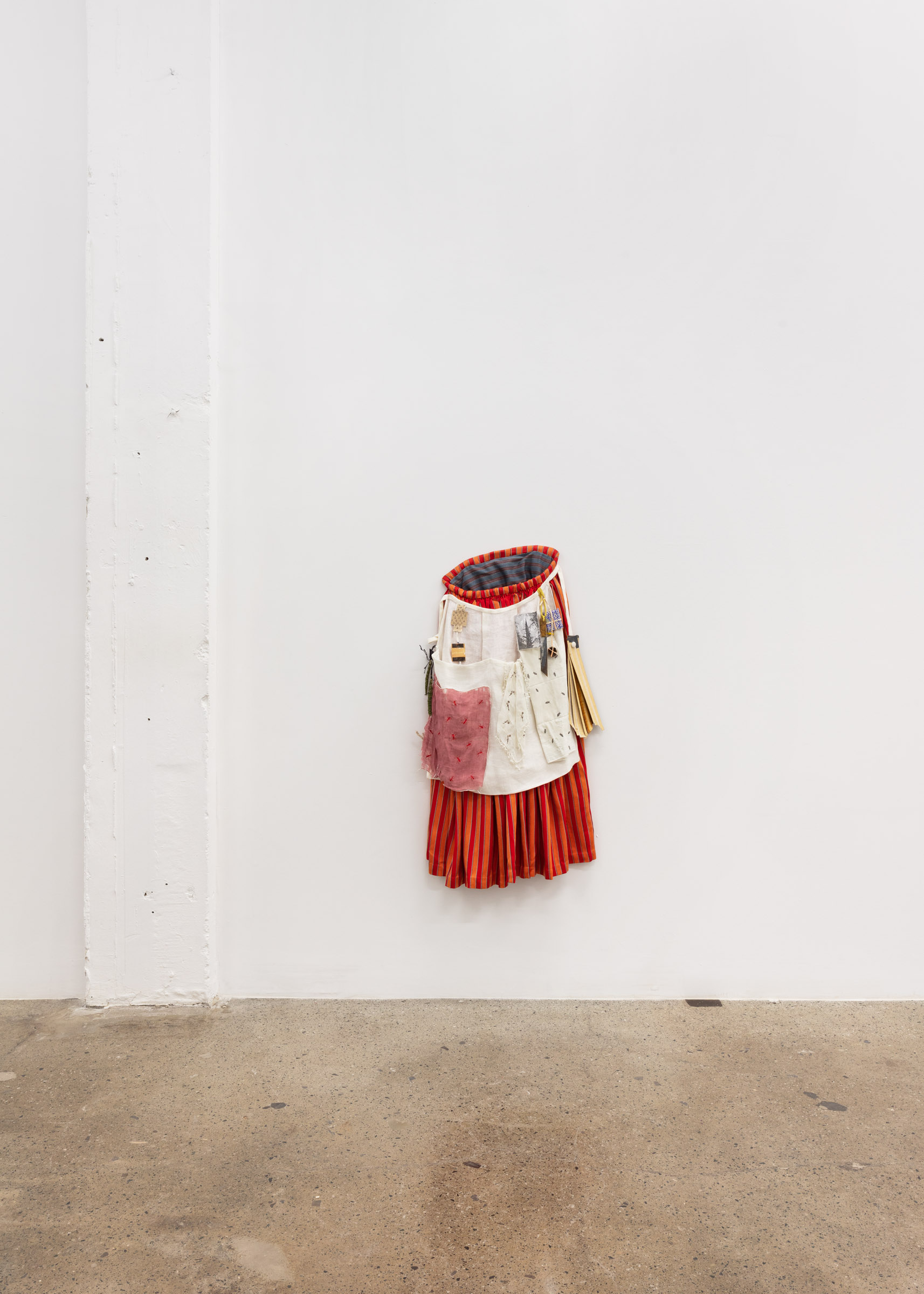
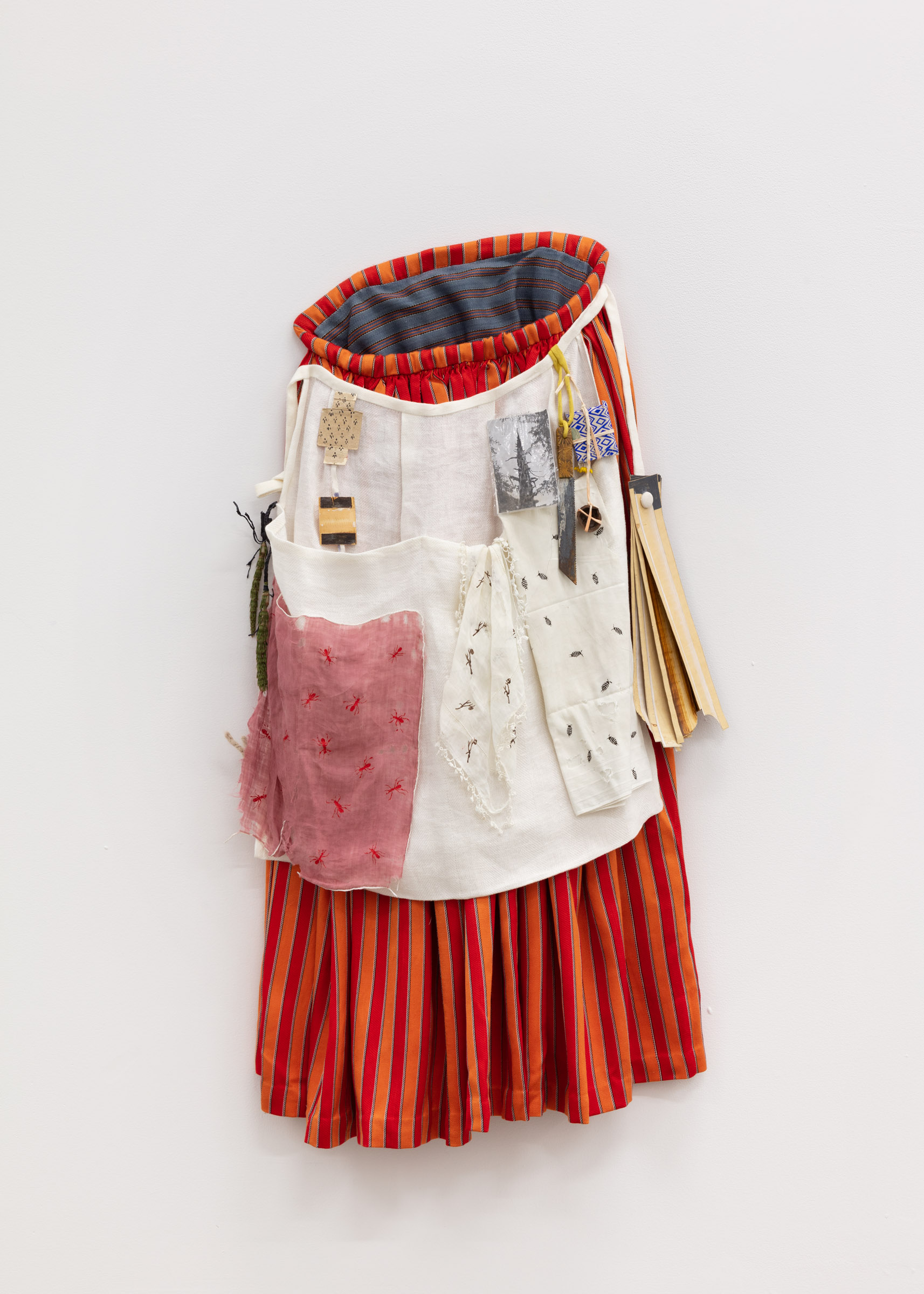
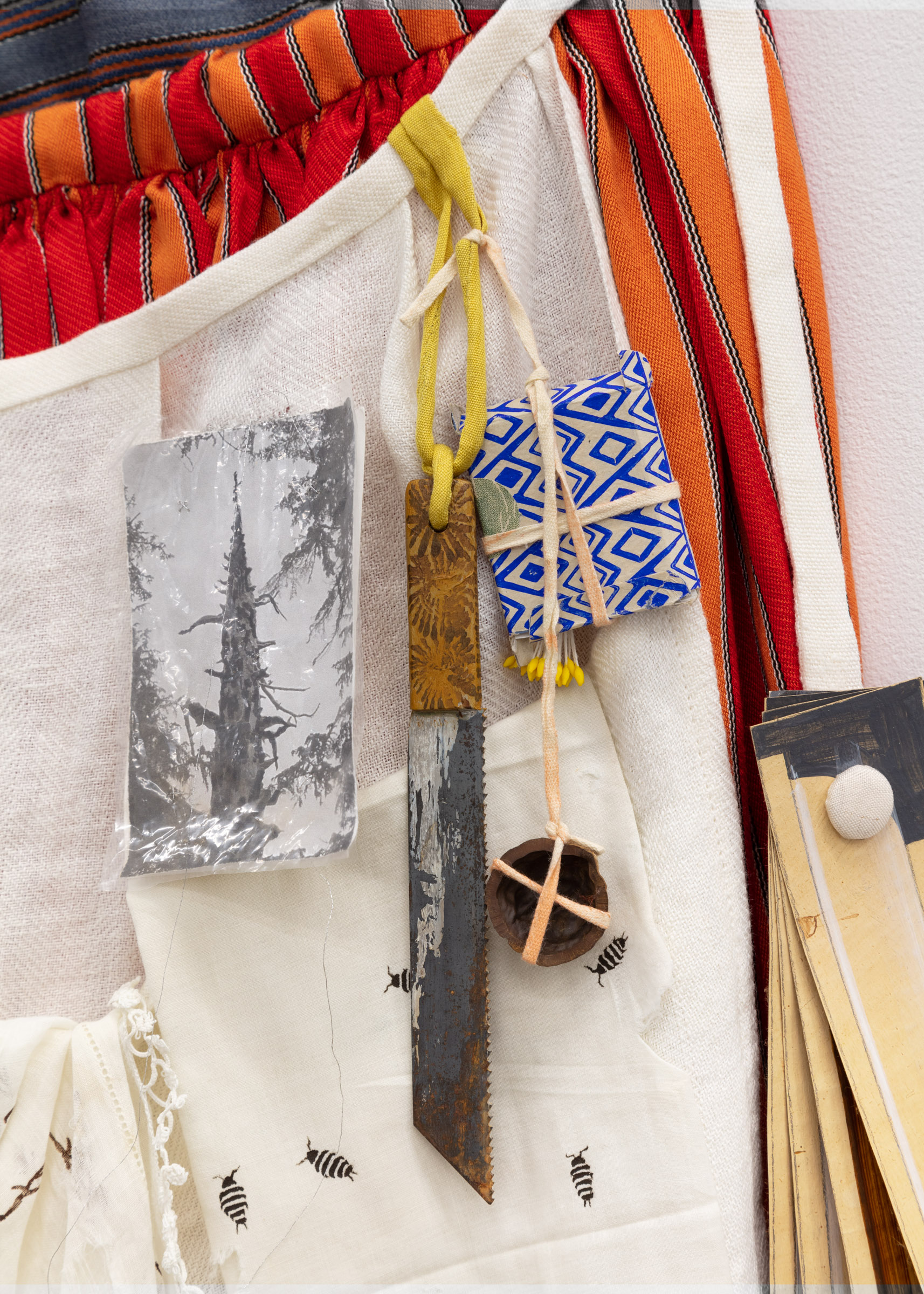
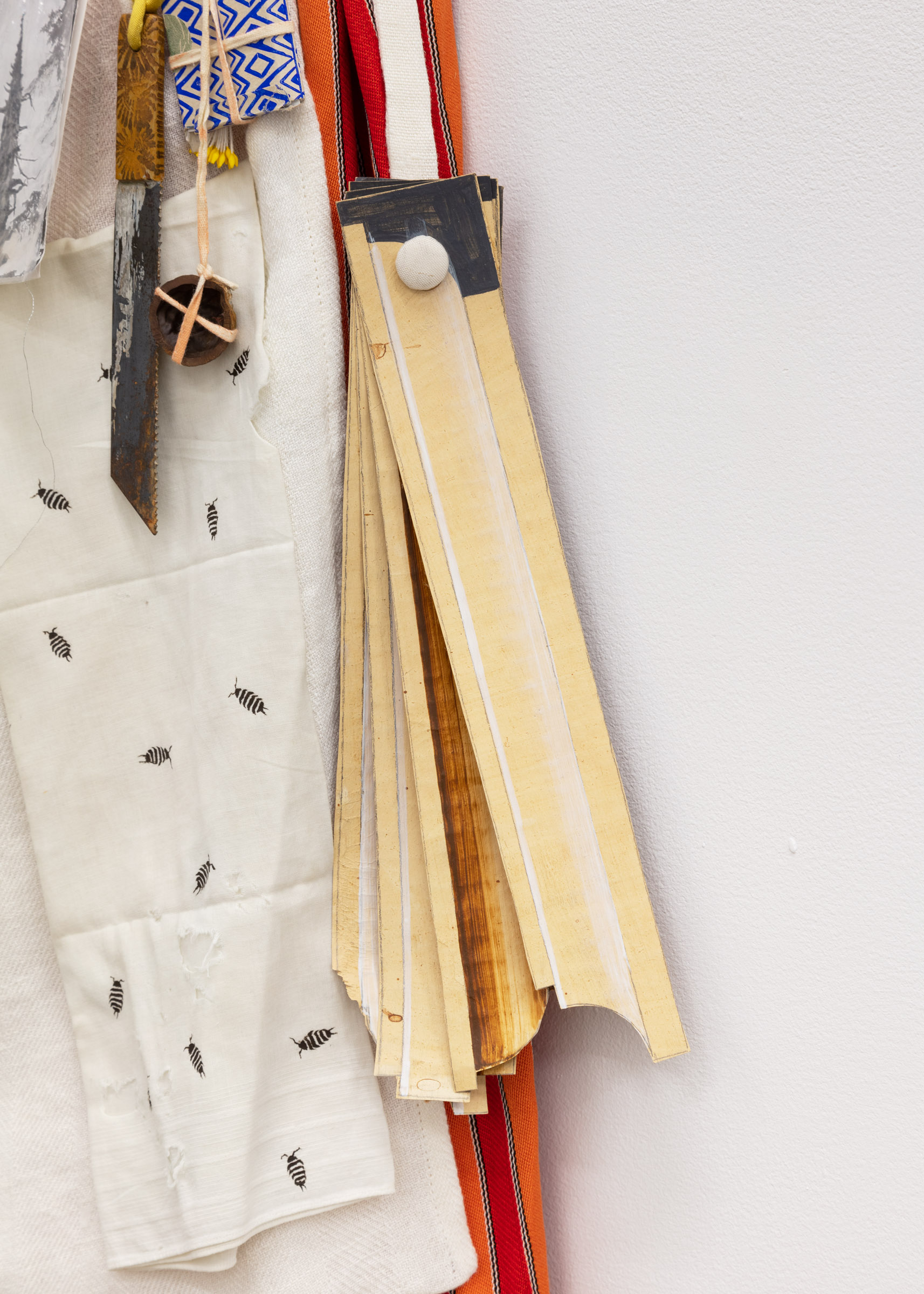
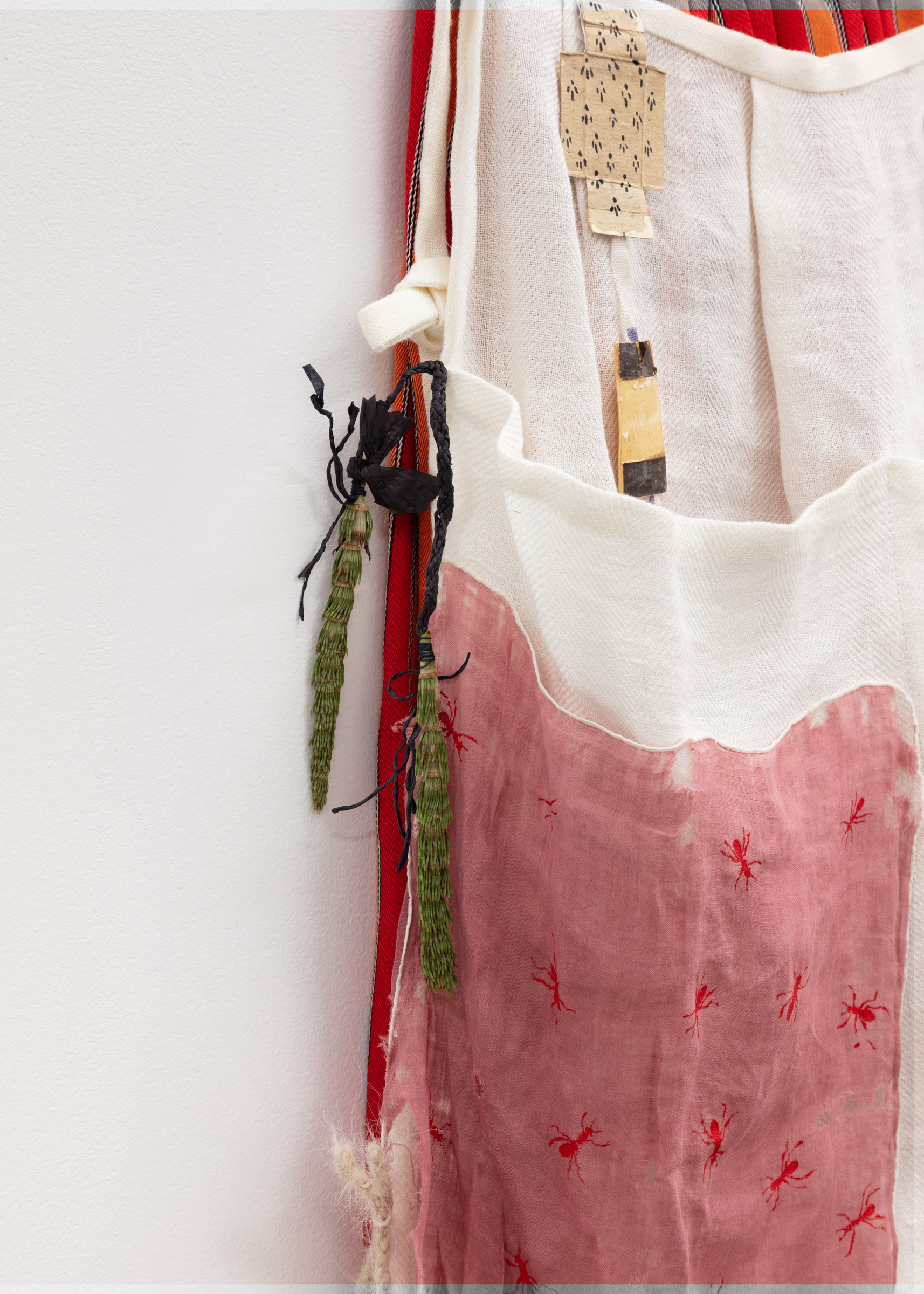
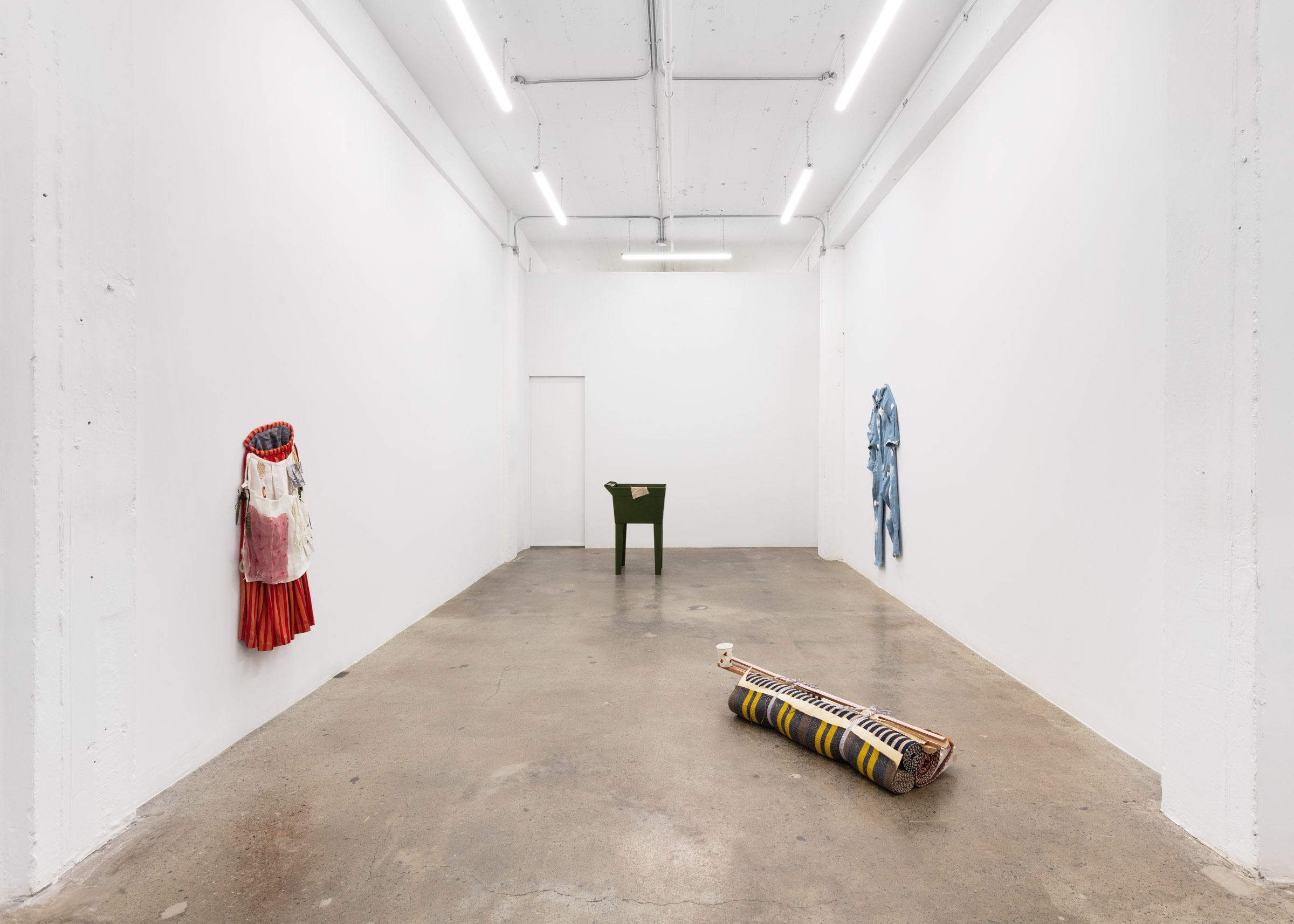


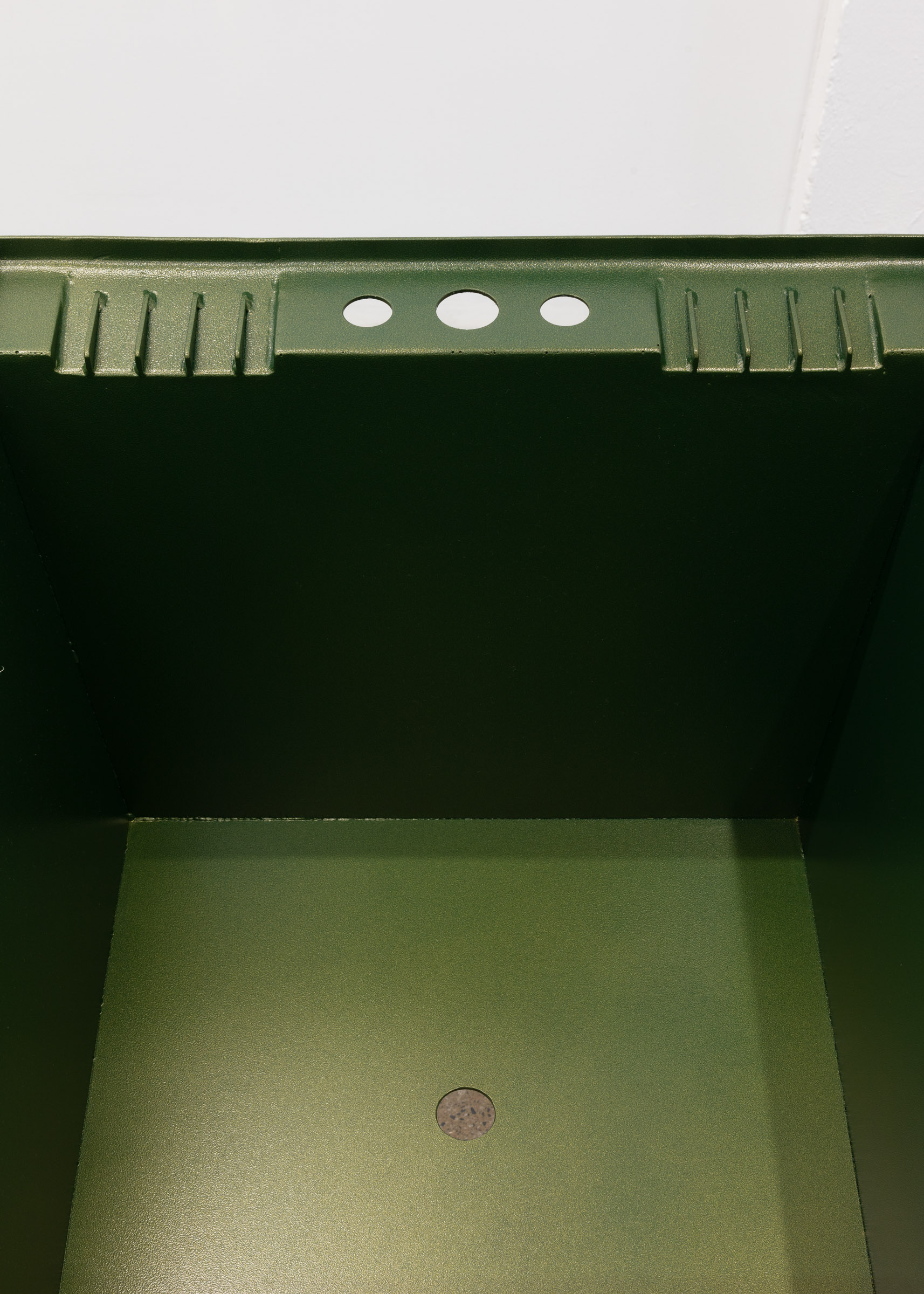
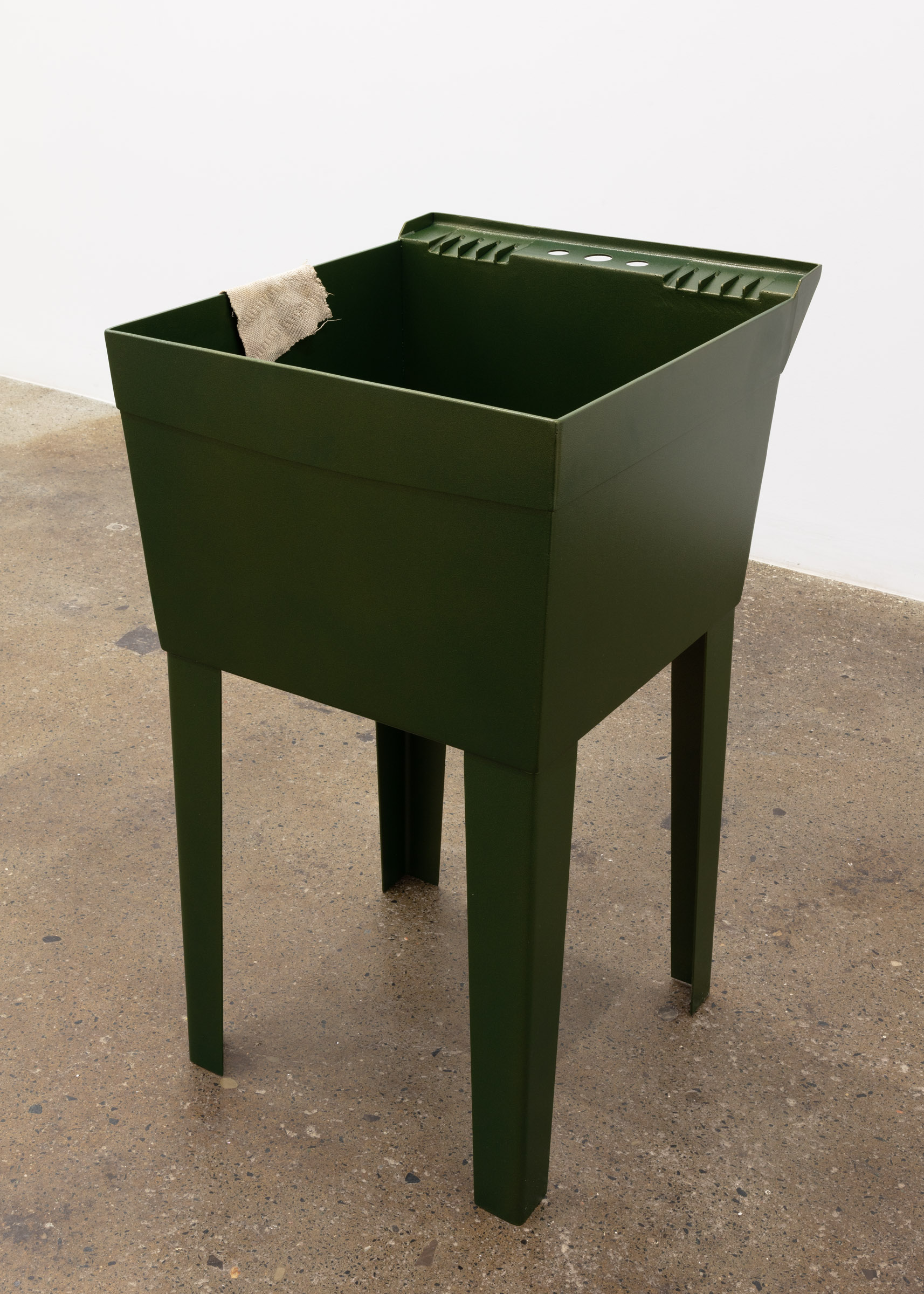
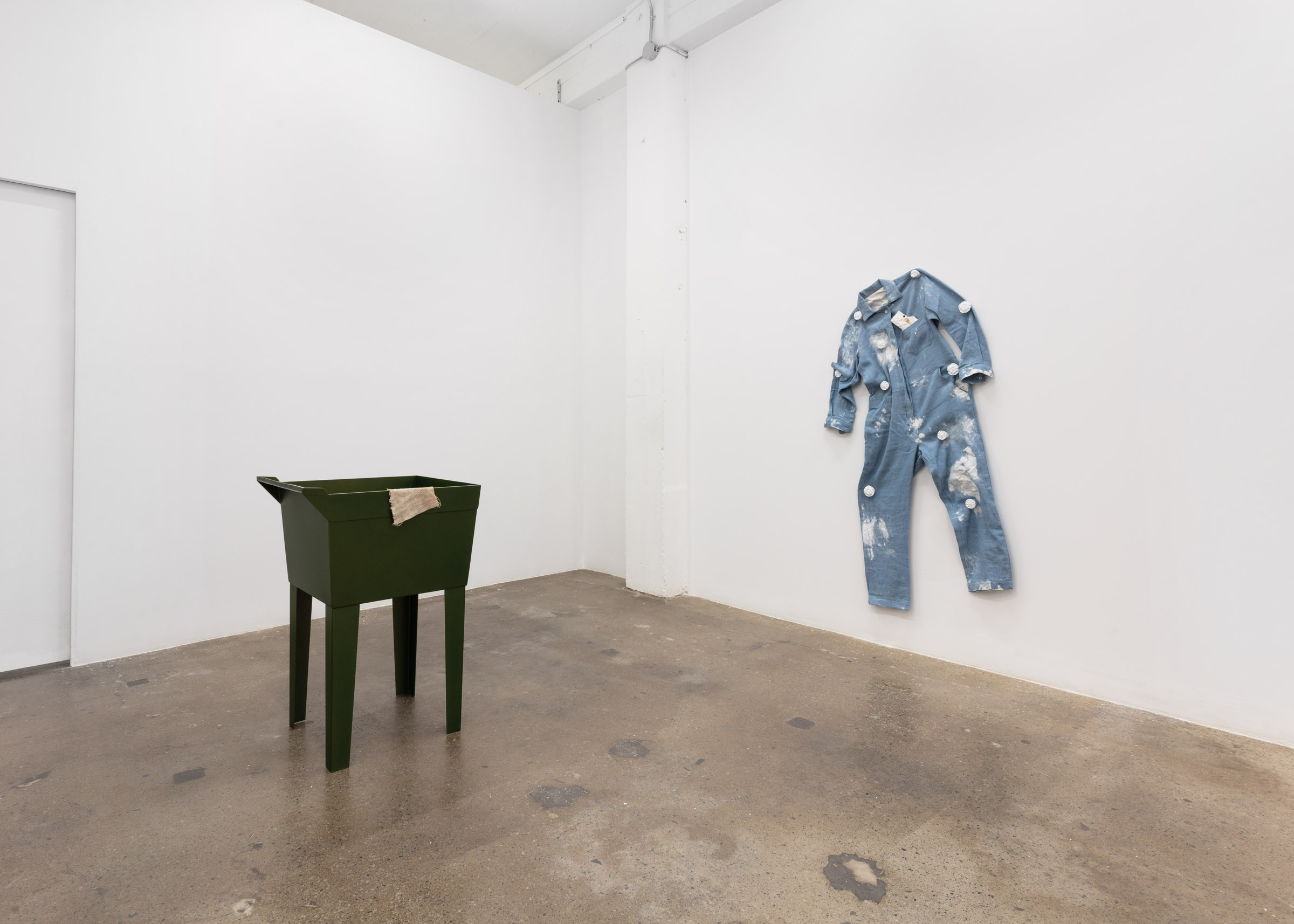
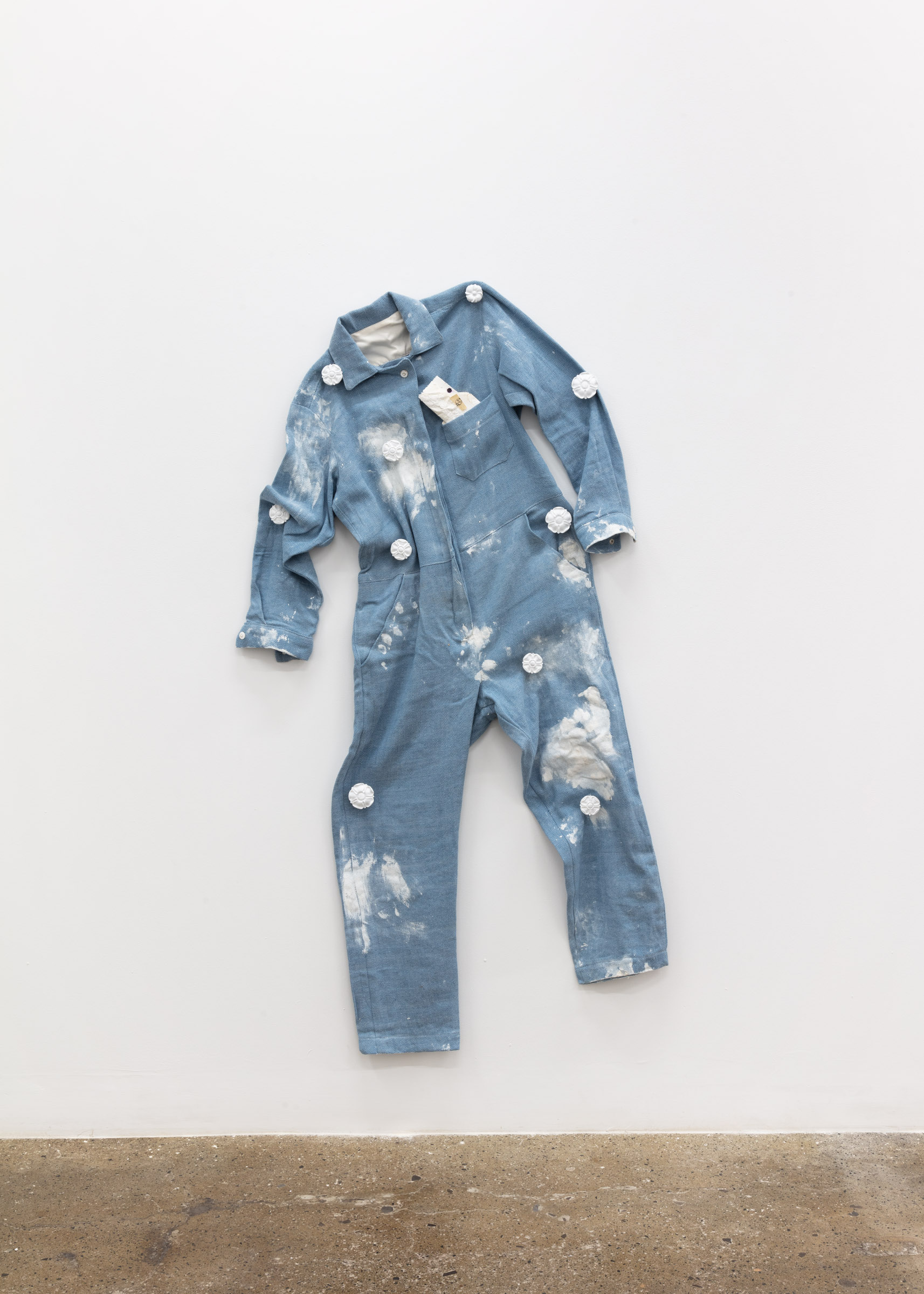
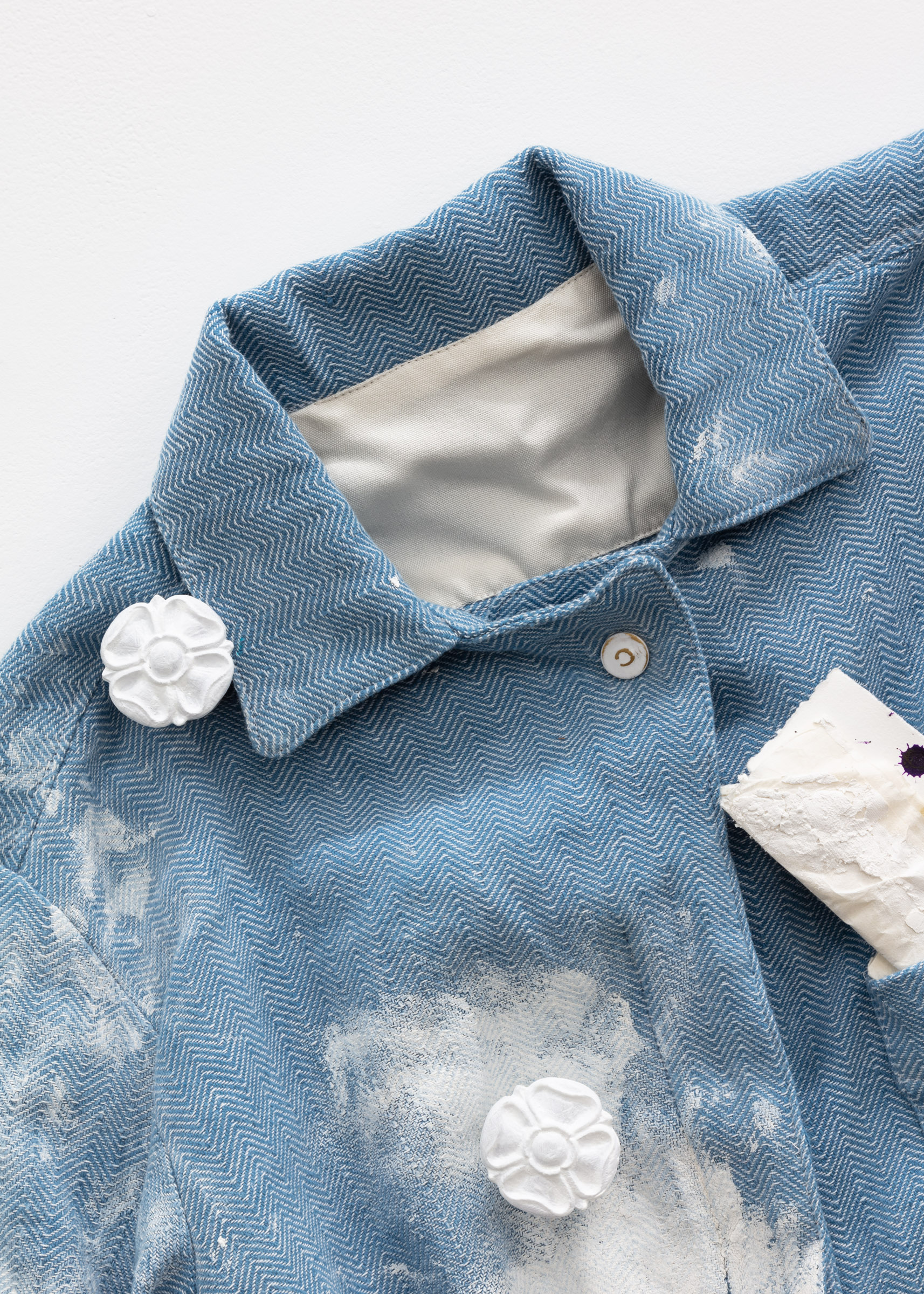

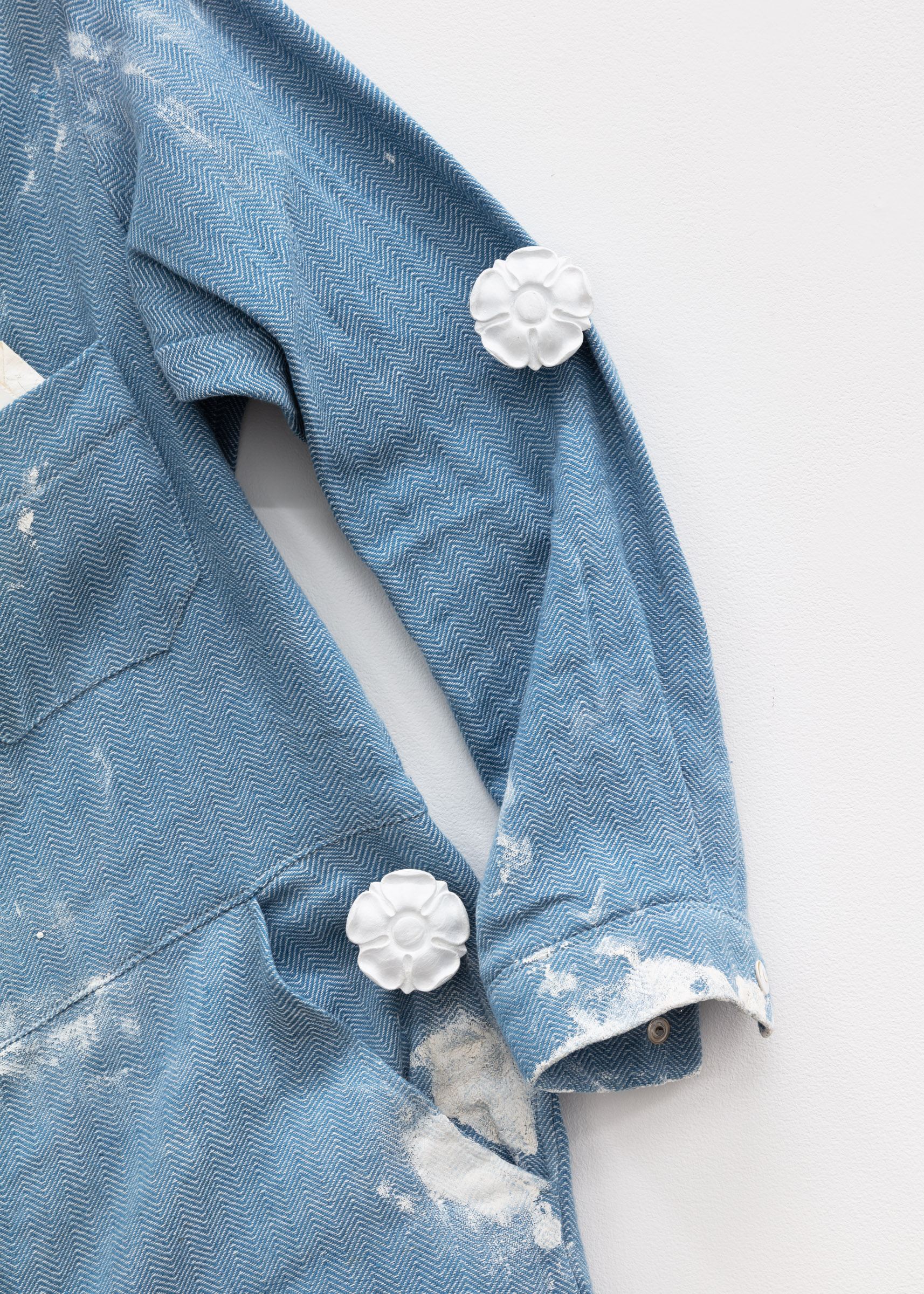
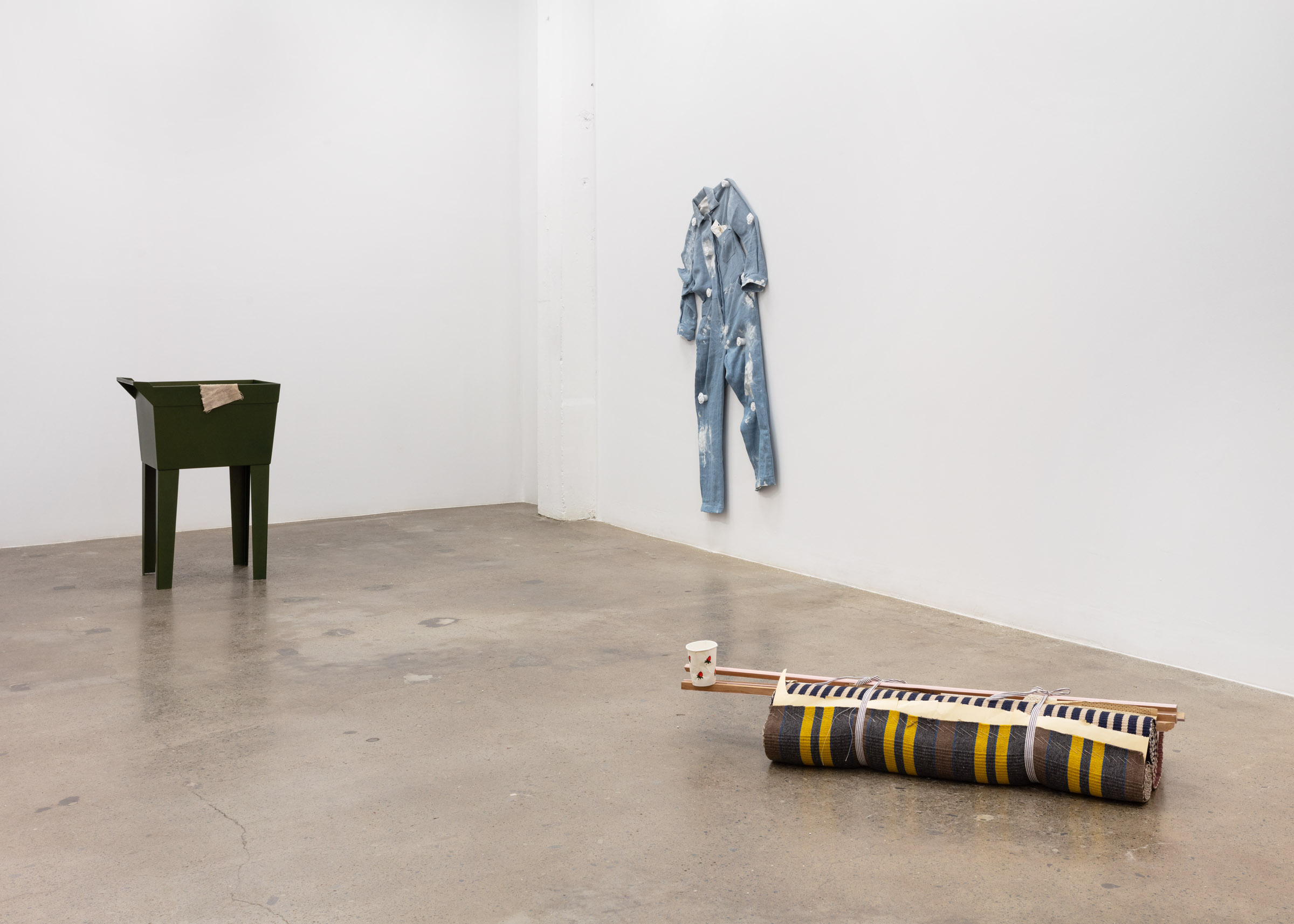
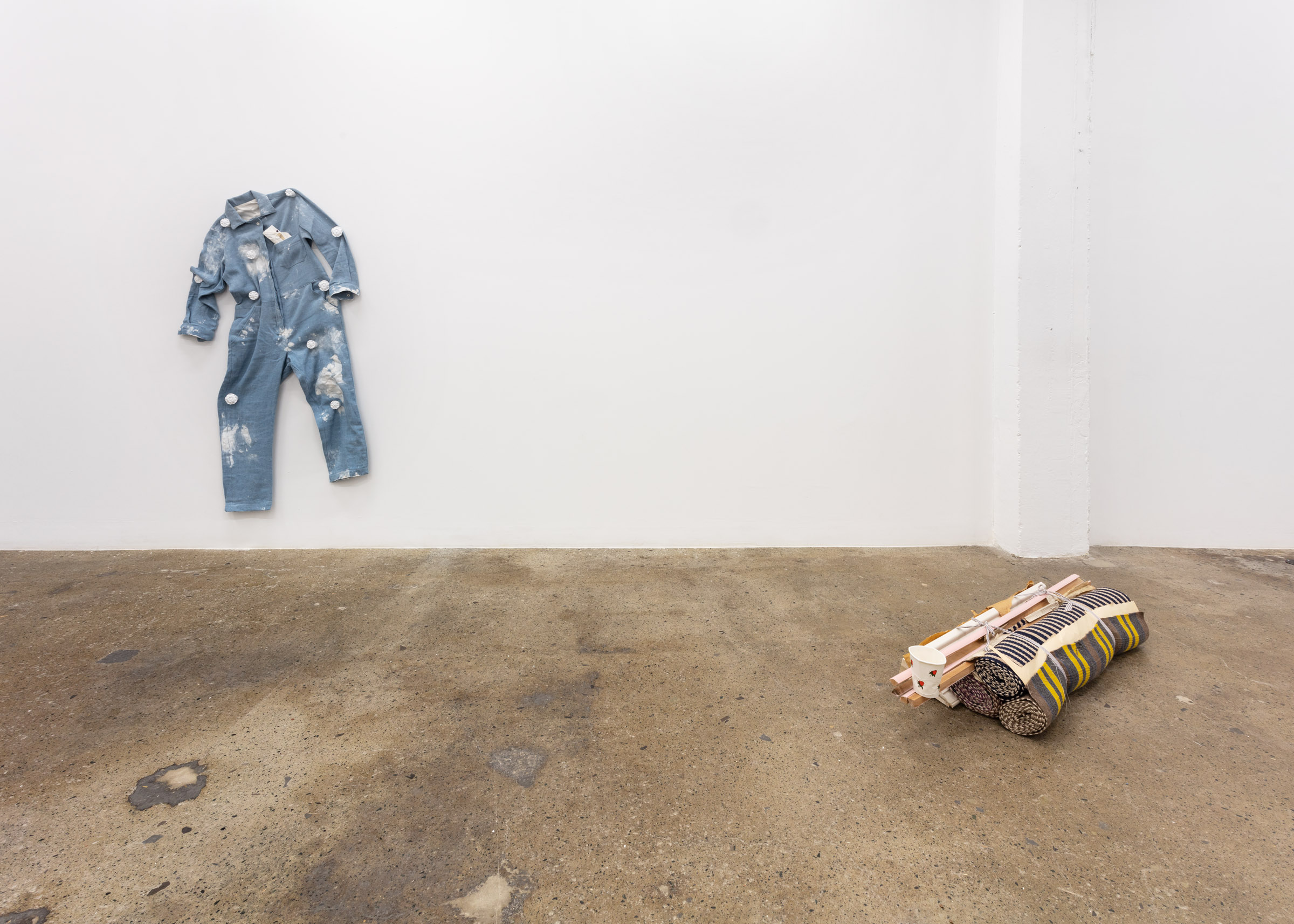

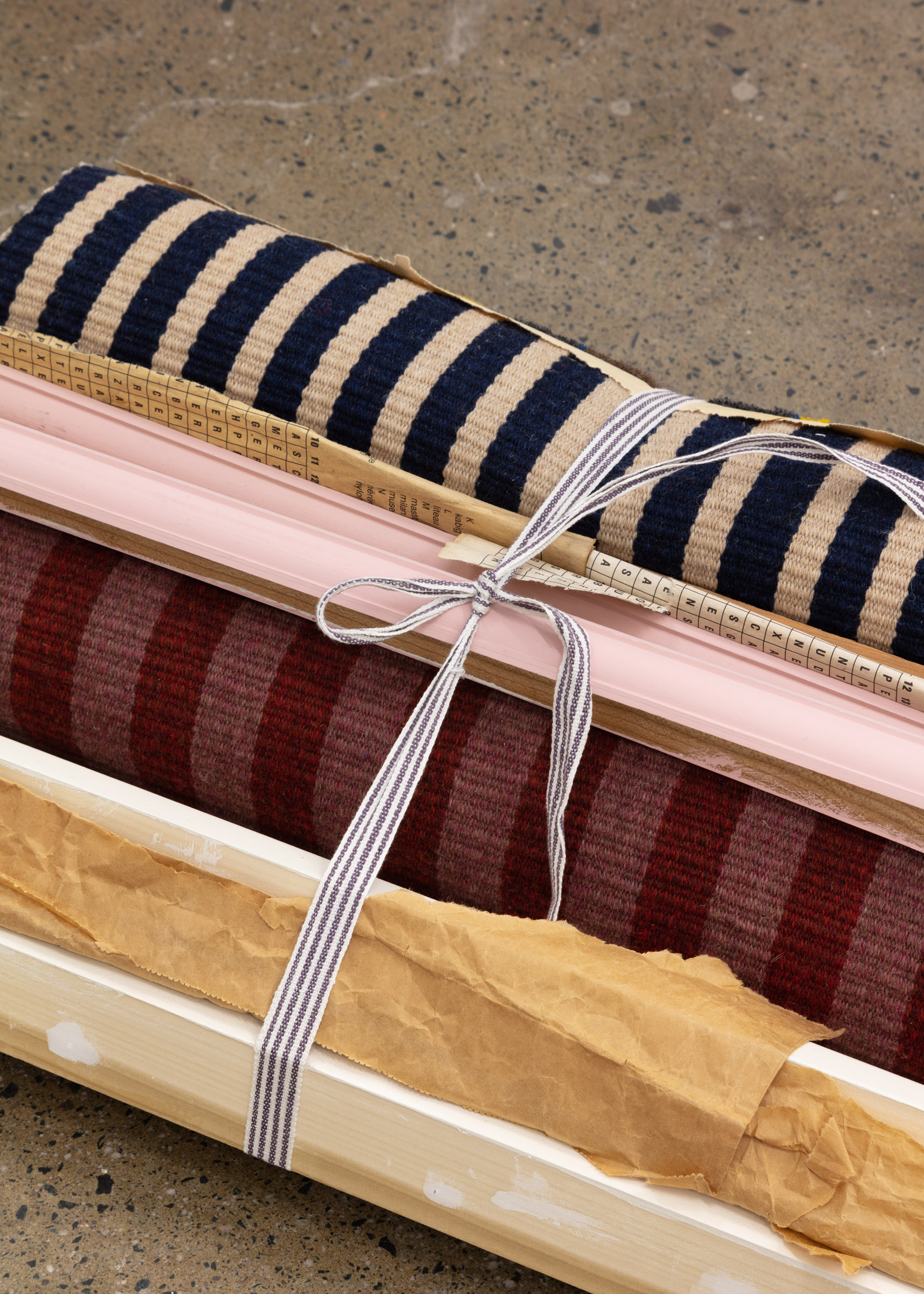
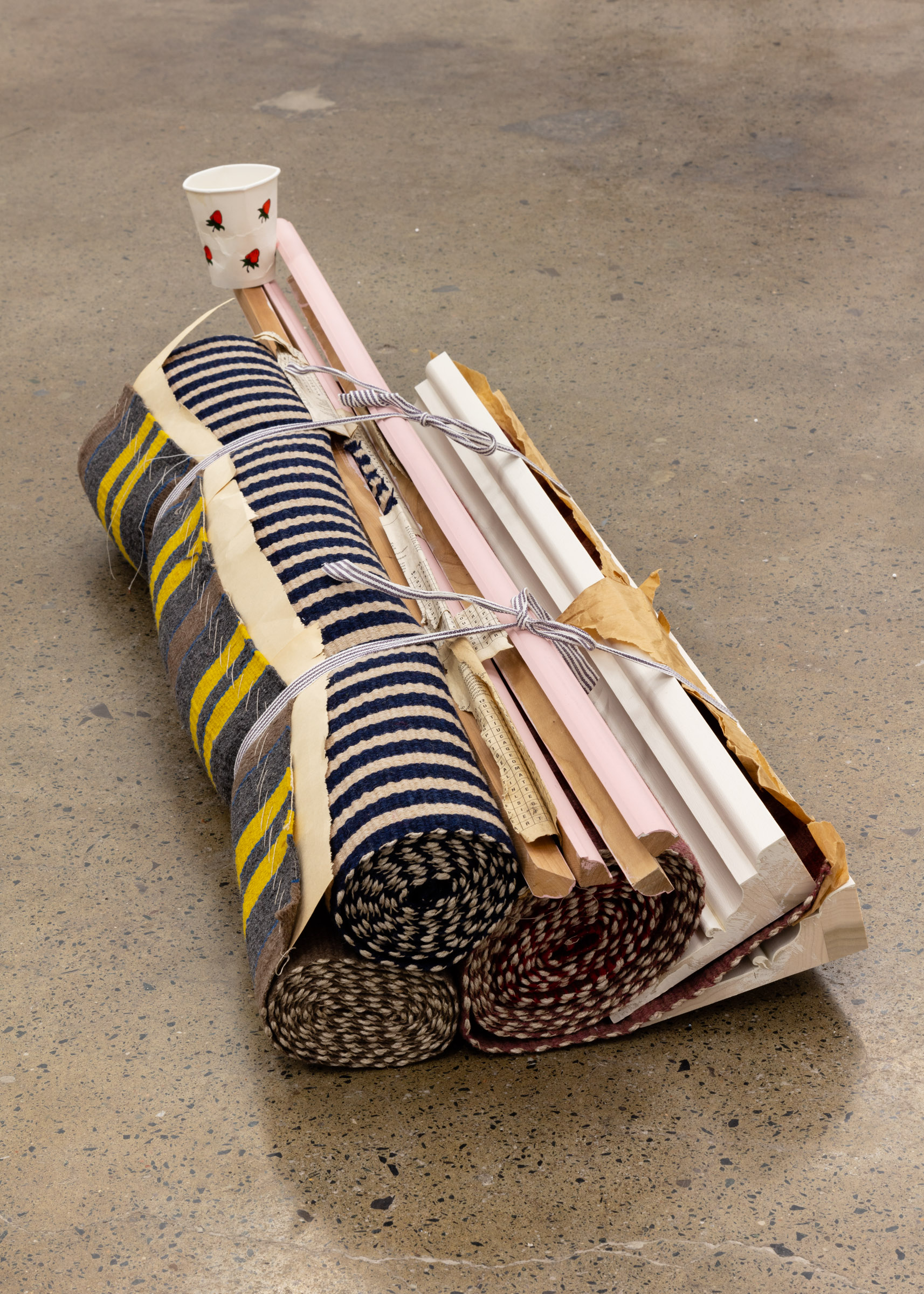


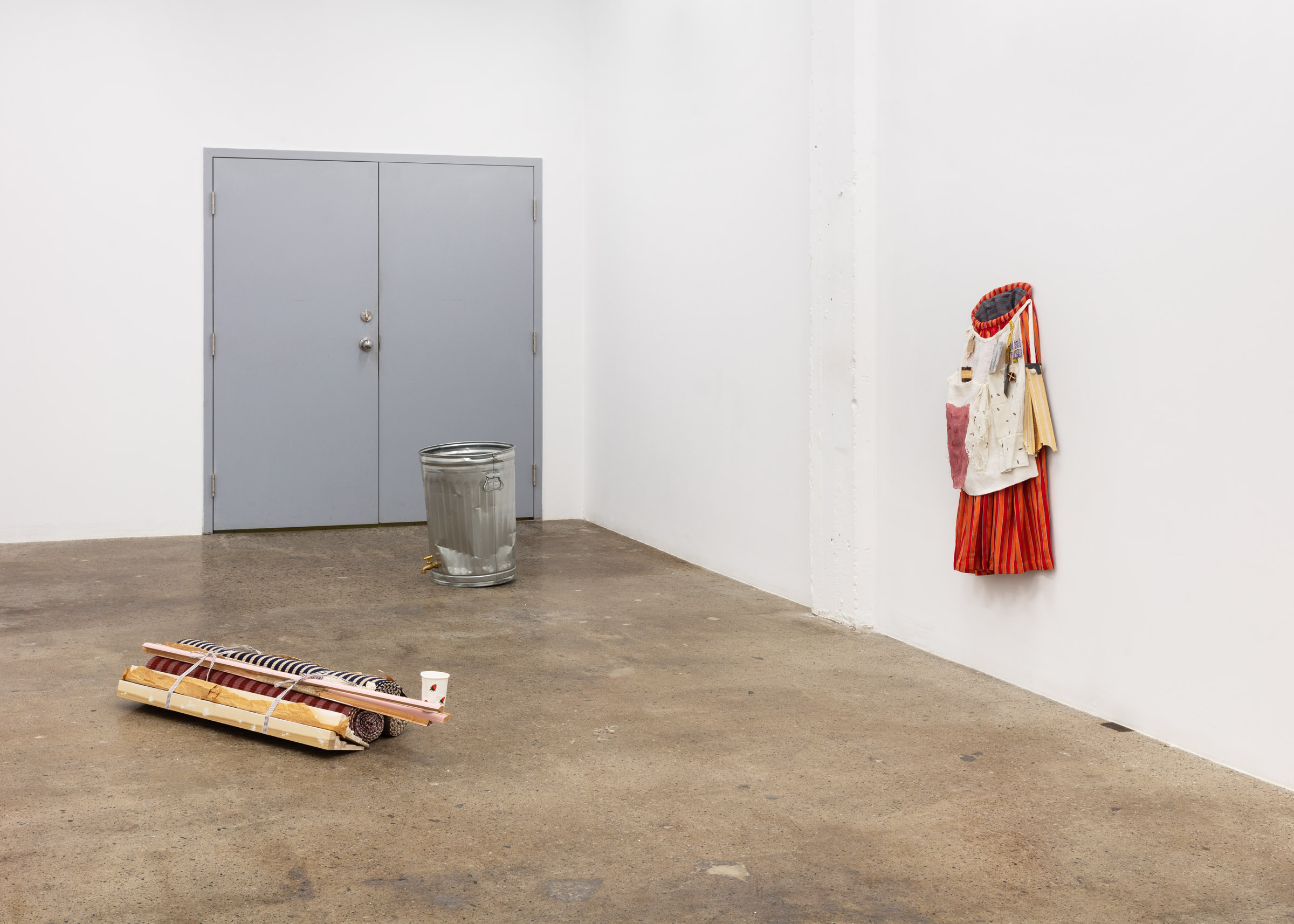
Anne Low’s work is meticulous. Described as an “artist-weaver,” Low is known for her handwoven textile works slowly crafted through research into the material doctrines of hand weaving techniques. Compelled by the encyclopedic skill and virtuosity of pre-Industrial cloth weavers, Low consciously takes the long route to arrive at material that is now mass-produced and available with blinding ease. Low describes how learning to spin, weave and dye brought her to an oblique path for making art where she didn’t have to begin with the premise of sculpture, but could rather come to it from the margins of a different discipline. [1]
Viewed together, the five artworks in Bury me, present an inventory of material-based labour: cleaning, maintaining, mending, rolling, and wrapping. These works extend Low’s engagement with the decoration of domestic spaces and the history of objects of women’s labour. These objects are of interest to Low as they provide evidence of ornamentation and taste that in turn offer views into the desires of the unconscious. [2]
Where other exhibitions, like Chair for a woman (Contemporary Art Gallery, Vancouver, 2019), have cited the contents and atmosphere of period parlour rooms and domestic architecture, the works in Bury me concern themselves with the often invisible activities and skills related to specific forms of labour. Chamber-lye (2020) presents itself as a powder coated steel facsimile of a free-standing laundry sink. A coarsely woven rag with threads like enlarged pores and frayed edges hangs over the basin’s side. It is faintly stained pink, as if it had sopped up a spot of spilt cranberry juice many washes ago. Garbage dyer (2020) is an upright, dented garbage can with a faucet protruding just above its base. It is inset with a structure of welded steel sitting inside the open mouth of the can. Hung from the metal is a piece of handwoven and indigo dyed wool pierced by bent nails that hold the cloth in a spiral. Day Labor (2020) consists of an assemblage of three handwoven carpets rolled and nested with pieces of paper and wood moulding. The ties that hold the elements together suggests the action of organizing objects in one’s house for storage or for transport. In tension with the bundle, a small paper cup sits on the far end of the wood moulding. The cup is painted with strawberries that reference a printed cotton fabric from the American 19th century.
These three works were all created for Low’s solo exhibition Figure like hearse (Southern Alberta Art Gallery, 2020) that was rarely open, it’s run interrupted by pandemic era closures. Low has expressed interest in the lives of artworks before, during, and after they are exhibited. Bury me will be the first time the works have emerged from storage since their only exhibition. The works play with the expectations that we have for functional objects to perform their exclusive duties. As Low says, “With textiles … they can move from function to display and consideration very easily, if given the right context or armature.” [3] Here, the contexts or armatures are the laundry sink, the garbage can, and the bundle ties that create a supporting diegesis for the fabric to be displayed.
The two most recent works in Bury me are connected to Low’s interest in the weaver as an anonymous, unnamed figure in history. Clay suitcase (2023) is a reproduction of an existing boiler suit pinned to the wall. The textile is a handwoven cotton and silk produced through a specific matrix of how Low thinks about cloth as a weaver, one not often dedicated to contemporary work garments. The uniform is covered in patches of plaster and punctuated with rosettes. The posture of the uniform, one arm and leg slightly raised, calls to mind the motion of the plasterer at work and of Low’s effort to “work with tools the scale of my limbs.” [4] The final included work, Dream meadow (2023) is a striped orange and red skirt with a pocketed apron attached. Various handkerchiefs and papers printed with small insignia (wood louse, carpenter ants and mildew) hang from the pockets, presenting the viewer with a material-based fiction. Both artworks reference the body, evoking the absented presence of the weaver.
Low routinely presents her work with a finely tuned attention to the “poetics of space.” [5] The term refers to a kind of spatial thinking where the sites of domesticity and intimacy, namely the home (and the artist’s studio), are considered to both shape and be shaped by the psyche of the inhabitants. [6] In addition to this spatial poeticism, Low also activates a poetics of material wherein the weaver not only produces and shapes the fabric, but where the woven textile also shapes whatever it comes in contact with, be it weaver, wearer, or laundry sink.
- Kate Whiteway
Anne Low is based on Denman Island, Canada. Recent solo exhibitions include Medlar, Unit 17, Vancouver (2021); Figure like hearse, Southern Alberta Art Gallery, Lethbridge (2020); Chair for a woman, Contemporary Art Gallery, Vancouver (2019); Bletting, Franz Kaka, Toronto (2019) and Paperstainer, Mercer Union, Toronto (2018). Recent group exhibitions include Interior, Michael Werner, London, UK (2022); New Acquisitions, Burnaby Art Gallery, Vancouver (2021); La machine qui enseignait des airs aux oiseaux, Musée d’art contemporain de Montreal (2020); and Anne Low & Dala Nasser, L’inconnue, Paris, France (2020). In 2017 Low was included in the Loewe Craft Prize, La Fundación Arquitectura COAM, Madrid; Chamber Gallery, New York; and 21_21 Museum, Tokyo. She was shortlisted for the 2019 Sobey Art Award.
-
[1] Sobey art award 2019 - Anne Low. YouTube. September 29, 2019, accessed on August 25, 2023, https://www.youtube.com/watch?v=d0sjPsR_QvQ
[2] Ibid.
[3] Orion Lecture: Visiting Artist Anne Low. YouTube. February 8, 2023, accessed on August 25, 2023, https://www.youtube.com/watch?v=7hZKkZGNpWs.
[4] Jonathan Foyle, “Fruits of the loom: Anne Low’s woven sculptures using historic weaving methods,” Financial Times. September 23, 2019, https://www.ft.com/content/040c12e8-b531-11e9-b2c2-1e116952691a.
[5] See The Poetics of Space by Gaston Bachelard (1958).
[6] In addition to spatial acuity, bespoke architectural elements often punctuate Low’s presentation spaces. In A forged spider’s web, a group exhibition that Low curated at Unit 17 in Vancouver, she added three architectural elements to the space that referenced artist’s homes where the practice of living overlaps with the making of work. For example, there was millwork recreated from a photograph of Louise Bourgeois’ kitchen in Chelsea where she had moved her stove and dining table to make room to make artwork. See Low’s curatorial essay here: https://www.unit17.org/a-forged-spider-s-web
